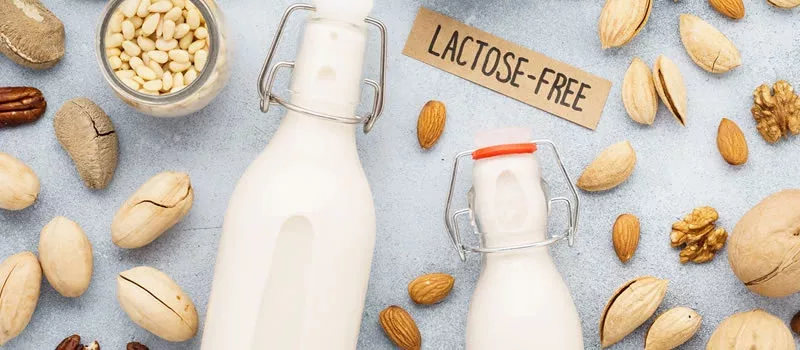
What can I eat on a lactose-free diet?
In this article
What is lactose intolerance?
Lactose intolerance is a common food intolerance where people produce insufficient levels of the enzyme lactase. This enzyme is needed to digest lactose, a sugar found in milk and dairy products. When dairy foods are eaten, the undigested lactose then passes through to the colon for bacterial break down causing gas and liquid, leading to symptoms of abdominal pain, bloating, diarrhoea and flatulence.
It’s estimated that up to 5% of Caucasians and 75% of non-Caucasians living in Australia are lactose intolerant.
What foods contain lactose?
Many people with lactose intolerance can handle small amounts of lactose, however, they should be wary of the following foods:
- Cow’s milk and milk products — Lactose is found in milk and milk products such as cheese, ice-cream, custard, cream, buttermilk, dips and whey.
- Low-fat and non-fat milk —Low-fat milk products travel faster through the intestine causing more symptoms for lactose-intolerant people. Additionally, many low-fat products contain skim-milk powder, which contains higher levels of lactose.
- Goat’s milk and milk products— As with cow’s milk, goat’s milk contains lactose, however, lactose-intolerant people may be able to consume small amounts.
- Biscuits and cakes — Milk or milk solids can be added to biscuits and cakes.
- Processed breakfast cereals — There could be hidden lactose in some breakfast cereals.
- Cheese sauce — Look for vegan cheese sauces if you want to avoid lactose.
- Cream soups — Check labels carefully for milk products in cream soups or look for a vegan variety.
- Milk chocolate —Dark chocolate with a high percentage of cacao usually won’t contain lactose but check the label for milk, milk solids or skim milk powder.
- Pancakes and pikelets — Shop bought pancakes and pikelets are often made with milk powder.
- Scrambled eggs — Milk is usually added to scrambled eggs.
- Lasagne, quiche and frittatas — These foods may be made using milk-based sauces.
- Muesli bars — Look out for yoghurt-covered muesli bars or those with hidden milk ingredients.
- Some bread and margarine — Check for milk-based ingredients.
- Fruit smoothies — May contain milk, yoghurt or whey protein.
- Some powdered chocolate drinks — These products often contain milk powders
- Protein powders and bars — Always check the label for potential sources of lactose such as whey, milk by-products or milk solids.
- Some salad dressings — Some salad dressings contain dairy eg. Ranch dressing
- Processed meats such as bacon, sausages, hot dogs and lunch meats — May contain small amounts of lactose.
- Battered meats — Some battered fish or chicken products can contain milk-based products
- Powdered coffee creamers — Powdered coffee creamers contain milk protein. This is may not be an issue for some lactose-intolerant people.
- Artificial sweeteners — Some artificial sweeteners contain lactose, check the labels carefully
- Prescription and over the counter medicines — Some medications can contain lactose. Speak to your pharmacist about lactose in your medications.
Tips for managing lactose intolerance
There are small changes you make to the way you eat to help you reduce your lactose intolerance symptoms:
Choose your dairy wisely
Hard cheeses such as cheddar and Edam or cottage cheese are generally well tolerated. Some people also tolerate butter and cream. Try yogurt and kefir, even though they have lactose in them, the live active cultures helps to break down the lactose.
Eat lactose-containing foods throughout the whole day
Spread your consumption of lactose-containing foods out throughout the day. Also, try combining them with other foods to try and reduce symptoms.
Swap to lactose-free products
Swap to lactose-free milk and yoghurt or try soy foods such as soy milk and yoghurt. There’s also a wide variety of vegan yoghurts and cheeses available in supermarkets that are lactose-free.
Try an over the counter product
Over the counter, lactase enzyme tablets are available for adults to help reduce the symptoms of lactose intolerance. Speak to your pharmacist to see if these products are suitable for you.
How do I get enough calcium if I’m not eating dairy?
Boost the calcium in your diet with these dairy-free alternatives:
- Fish — ½ cup (100g) fish with edible bones e.g. canned salmon or sardines*
- Tofu — 100g firm tofu fortified with calcium*
- Nuts — Nuts and seeds e.g. cashews, almonds, sesame seeds, tahini paste
- Cereals — Calcium-fortified foods e.g. breakfast cereal or bread
- Vegetables — Dark green leafy vegetables e.g. kale, bok choy, broccoli, spinach
- Legumes — Legumes such as baked beans, chickpeas and black beans
- Calcium supplements — calcium supplements are available if your dietary intake of calcium is inadequate. Look for a calcium tablet containing calcium in an amino chelate form for better calcium absorption. A good calcium supplement for bone health will also contain vitamin D3 and magnesium which are also needed for strong bones.
Managing lactose intolerance involves knowing which foods you’re sensitive too and minimising your exposure to those foods. There is a wide variety of calcium-rich lactose-free options available in supermarkets and health food stores. Speak to your healthcare practitioner if you are concerned about your calcium levels, as calcium supplementation may be required.
*These are the best non-dairy sources of calcium. They provide the same amount of calcium as 1 serve of dairy.